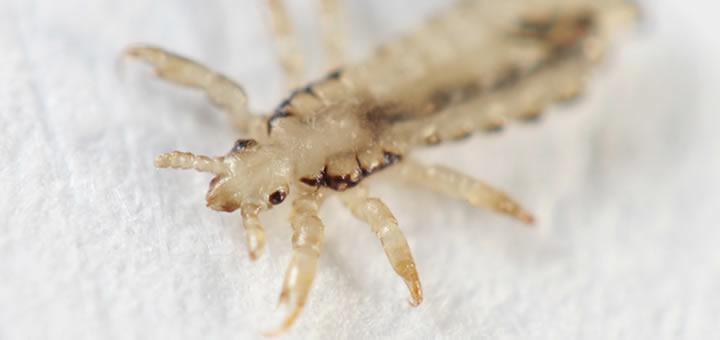About Lice and Their Control
On this page:
Basics

Photo Credit: Mike Merchant (Texas A&M University)
Head Lice: Head lice are tiny parasites that attach to human head hair and feed on blood through the skin.
Head lice (Pediculus P. humanus) are one of 500 species of "sucking louse" that feed on mammalian blood, but one of only three species that feed specifically on human blood. Lice are wingless insects and, therefore, have six legs, three body segments (the head, thorax and abdomen), and two antennae.
Life Cycle
Head lice live in three phases: eggs/nits, nymphs and adults.
Head lice are "oviparous," which means that they lay eggs, and embryos develop almost entirely outside of the mother (and within the egg).
Eggs live attached to hair on the scalp. They appear yellow but are generally too small to see. In this life cycle phase, head lice do not feed on human blood.
Eggs transition into nymphs after about one week and then feed every few hours. The body of the nymph turns dark red after feeding. Nymphs survive for eight to nine days and then transition into adults, which can live for one month.
Read more about the biology of lice and the lice life cycle.
Mobility
Head lice cannot fly, but they can crawl into sweaters, towels, hair accessories and blankets, which is generally how transmission occurs. It is possible for lice to survive for several hours in water (such as in a pool), but this kind of transmission from person-to-person is rare.
Health Concerns and Treatment Tips
According to the Centers for Disease Control and Prevention, lice are not known to transmit any disease, and are, therefore, not a public health hazard. However, head lice infestations do requirement treatment and can be prevented. Follow these principles in your treatment plan:
- Don't treat family members who don't have head lice. Treat for head lice ONLY when a person has them.
- Check everyone in the family using a good quality lice removal comb.
- Avoid pesticide-based shampoos.
- Shampoo hair with normal shampoo.
- Use clips to divide wet hair into small sections, and work with one section at a time.
- Comb from the scalp, depositing lice and eggs in a bowl of soapy water.
- Some people report using conditioner and leaving it in the hair makes the process easier.
- Use a fine-toothed, good quality metal comb.
- Don’t use environmental sprays for lice - they are unnecessary and can pose a health risk if used improperly.
- Lice infect people, not the home.
- They are human parasites. Lice cannot live without human blood for more than 24 hours.
- Nits will not live unless they get a meal of human blood as soon as they hatch.
- Vacuum carpets and padded furniture to remove hairs with attached nits and any lice that crawl off the infested person.
- Put bed linens, pillows, stuffed animals and similar items in a dryer for 30 minutes on high heat to kill both live lice and nits.
- Lice do not jump or hop. They do crawl and cling.
- If a louse comes off the head and is left behind on a pillow, head rest, or hat, the louse may infect another person who places their head in that area. Vacuuming will catch these escapees.
- Experts used to suggest bagging items such as stuffed animals for several weeks to help control infestations, but this is now recognized as unnecessary.
- Don’t treat family pets for lice with insecticidal shampoo. It is potentially harmful (to both humans and pets). Lice cannot live on pets, so there is no reason to fear that lice may be hiding on your dog, cat or guinea pig.
- Don’t use head lice treatments as a preventive measure. Head lice can’t be safely or effectively prevented by shampooing with either chemical or alternative treatments.
- Practice early detection, by making weekly head checks with a good quality comb. Early detection and removal of any live lice or nits can keep head lice problems to a minimum. “It only takes a few minutes,” says Bonnie Byers, parent of four. “I check around the ears, the back of the neck, around the bangs and where hair is parted. Lice seem to like these areas best.”
Additional Resources
The following links exit the site Exit
- Biology and Control of Head Lice - A quick introduction to head lice, exposure at school, prevention and control options. The web page was developed by the University of Florida School IPM program.
- Head Lice: Management Tools for a Healthy Learning Environment (PDF)(2 pp, 956.1KB K, About PDF) - A colorful flier on lice identification, prevention and home treatment.
- Michigan Head Lice Manual (PDF) (44 pp, 2.17 MB) - A 44-page comprehensive guide for parents, school staff and administration on preventing and responding to head lice transmission among students.
- A fact sheet on head lice from the Wisconsin Department of Health Services, available in English, Spanish and Hmong.
- How to Protect your Home From Lice - This provides information about head lice. It covers the areas of prevention, how lice spread, how to check for lice and ways to manage and get rid of them.
